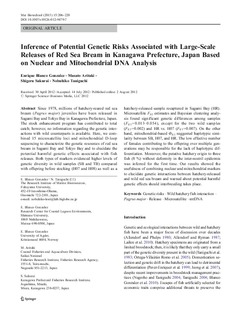| dc.contributor.author | Gonzalez, Enrique Blanco | |
| dc.contributor.author | Aritaki, Masato | |
| dc.contributor.author | Sakurai, Shigeru | |
| dc.contributor.author | Taniguchi, Nobuhiko | |
| dc.date.accessioned | 2013-07-18T11:39:55Z | |
| dc.date.available | 2013-07-18T11:39:55Z | |
| dc.date.issued | 2013 | |
| dc.identifier.citation | Gonzalez, E.B., Aritaki, M., Sakurai, S., & Taniguchi, N. (2013). Inference of potential genetic risks associated with large-scale releases of red sea bream in Kanagawa prefecture, Japan based on nuclear and mitochondrial DNA analysis. Marine Biotechnology, 15(2), 206-220. doi: 10.1007/s10126-012-9479-7 | no_NO |
| dc.identifier.uri | http://hdl.handle.net/11250/138271 | |
| dc.description | Published version of an article from the journal: Marine Biotechnology. Also avialable from SpringerLink: http://dx.doi.org/10.1007/s10126-012-9479-7 | no_NO |
| dc.description.abstract | Since 1978, millions of hatchery-reared red sea bream (Pagrus major) juveniles have been released in Sagami Bay and Tokyo Bay in Kanagawa Prefecture, Japan. The stock enhancement program has contributed to total catch; however, no information regarding the genetic interactions with wild counterparts is available. Here, we combined 15 microsatellite loci and mitochondrial D-loop sequencing to characterize the genetic resources of red sea bream in Sagami Bay and Tokyo Bay and to elucidate the potential harmful genetic effects associated with fish releases. Both types of markers evidenced higher levels of genetic diversity in wild samples (SB and TB) compared with offspring before stocking (H07 and H08) as well as a hatchery-released sample recaptured in Sagami Bay (HR). Microsatellite F (ST) estimates and Bayesian clustering analysis found significant genetic differences among samples (F (ST) = 0.013-0.054), except for the two wild samples (F (ST) = 0.002) and HR vs. H07 (F (ST) = 0.007). On the other hand, mitochondrial-based Dcurrency sign (ST) suggested haplotypic similarity between SB, H07, and HR. The low effective number of females contributing to the offspring over multiple generations may be responsible for the lack of haplotypic differentiation. Moreover, the putative hatchery origin to three fish (8 %) without deformity in the inter-nostril epidermis was inferred for the first time. Our results showed the usefulness of combining nuclear and mitochondrial markers to elucidate genetic interactions between hatchery-released and wild red sea bream and warned about potential harmful genetic effects should interbreeding takes place. | no_NO |
| dc.language.iso | eng | no_NO |
| dc.publisher | Springer | no_NO |
| dc.title | Inference of potential genetic risks associated with large-scale releases of red sea bream in Kanagawa prefecture, Japan based on nuclear and mitochondrial DNA analysis | no_NO |
| dc.type | Journal article | no_NO |
| dc.type | Peer reviewed | no_NO |
| dc.subject.nsi | VDP::Agriculture and fishery disciplines: 900::Fisheries science: 920 | no_NO |
| dc.source.pagenumber | 206-220 | no_NO |
| dc.source.volume | 15 | no_NO |
| dc.source.journal | Marine Biotechnology | no_NO |
| dc.source.issue | 2 | no_NO |
